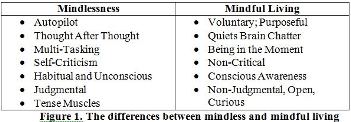
Mindfulness and its Impact on Health and Safety
Mindlessness is habitual, automatic, repetitive behavior generally brought on by multi-tasking. It can directly impact an individual's overall wellness, stress level, listening skills, injury risk and safety, and more.
- By Kris Corbett
- Jul 15, 2019
Mindfulness is a practice that heightens our awareness, a tool that allows you to be responsive instead of reactive, and a method to help quiet constant brain chatter. Also known as staying in the present moment, mindfulness has applications at home, in relationships, and especially in the workplace. According to a recent study, employees who practice mindfulness are more productive, safe, and resilient and have a more positive outlook on life than those who do not practice (Elder 2014). It can be utilized on a daily basis to impact nutrition, stress, injury prevention, and additional topics specific to a worker. Body mindfulness also can be applied to understanding how the body feels while performing tasks, promotes addressing body mechanics, and encourages proactive action on muscular skeletal disorders.
Mindlessness and the Impact on Health and Safety
Often, exploring mindlessness and its origins or triggers can provide greater understanding to mindfulness and mindful practice. Mindlessness is habitual, automatic, repetitive behavior generally brought on by multi-tasking. It can directly impact an individual’s overall wellness, stress level, attention, work and productivity, listening skills, injury risk and safety, and family relationships. Here are a few samples of mindless living and how it directly impacts a worker's health and safety.
1. Highway Hypnosis is most commonly found in individuals who consider themselves experienced in the operation of machinery. Operating any type of machinery without full attention on the task clearly sets the stage for a safety hazard.
2. Multi-tasking is the process of doing more than one task at a time. Although some multi-tasking has a place and purpose, most multi-tasking is a thief. Multi-tasking has been shown to steal time, take away from quality and accuracy, and even negatively impact an individual's mental health (Cravenshaw 2008).
3. Each time the body experiences any form of stressor (positive, negative, physical, or emotional), the sympathetic nervous system responds in the same way: increased breathing rate, elevated blood pressure, sweating, tense muscles, gastrointestinal dysfunction, dizziness, decreased immune function, and heightened sensitivity to light and sound. Constantly living with these physical conditions without appropriate ways to cope has been directly related to impacting both an individual’s health and risk for injury (Williams and Anderson 2012).
Origins of Mindlessness
Thanks to the introduction of smartphones, American workers have an increased amount of connection to their workplace. Due to the amount of time spent outside of the workplace checking emails, taking calls, and physically working from mobile devices, it is estimated that the average American’s 40-hour work week has turned into 72 hours a week (Eblin 2014). Eblin also approximates that a total of 56 hours is spent on the basic necessities of life such as eating, sleeping, and bathing. With only 168 hours in a week, simple math equates to only 40 hours for everything else (family and relationships, hobbies and activities, chores and transportation, exercise, and relaxation).
168 hours – (72 hours connected to work + 56 hours for necessities) = 40 hours
With only 40 hours available to do what gives individuals enjoyment, a sense of purpose, and happiness, American workers are rushed, overworked, and overwhelmed. In order to keep up with unrealistic expectations, mindlessness, autopilot, and reactive responses to stimuli have taken over. It has been found, however, that this can be reversed. Simply being aware that one hasn't been aware is very motivational to making sustainable and positive change.
Keys to Mindful Living
As shown in Figure 1, being mindful may simply be taking a purposeful approach to daily life and everyday tasks or practicing non-critical thinking.

Mindfulness is referred to as a practice because it is a skill that requires regular maintenance and exercise. Practicing mindfulness doesn't require any fees, a significant time commitment, epiphanies, or even a major lifestyle change. Below are five exercises to unlock mindful living.
1. Slow down: A common complaint among workers is that when late for work, they rush out of the house, only to realize they had forgotten something needed for the workday. Upon noticing the need to rush, an individual can elicit his or her own thinking by asking "What do I need to complete my tasks today?" Utilizing this simple question is a form of mindful living that can directly impact workers’ safety by ensuring they have the tools necessary to complete the job.
2. Focus: Society places a constant pressure on an individual to multi-task. Making an effort to do one task at a time can improve a person's ability to stay in the present moment. Texting while driving is illegal in some states for a reason; doing so causes distraction and puts all drivers on the road at risk for injury. Reducing the amount of time spent multi-tasking increases the amount of time spent living mindfully. By focusing on one task, such as operating an automobile without distractions, the risk for injury decreases.
3. Engage the senses: Sensory engagement is one of the simplest and quickest ways to get grounded and centered. After developing an awareness of operating in mindlessness, paying attention to the details of what can be heard, seen, felt, tasted, or smelled is a tool for switching the autopilot off. In addition to being fully present, this type of exercise also allows for practice of switching from mindlessness to mindfulness. With further practice, the skill is then applied in other areas of an individual's life that will directly impact the ability to be safe and work injury free.
4. Body mindfulness: Body mindfulness is being aware of signals the body is communicating, exploring the origin, and taking action to address the causes. A study in 2007 showed that most workers described working through pain as "just part of the job" (Silverstein and Adams). This attitude and perception of body mindfulness creates a greater risk for workplace injury. Instead of ignoring or accepting discomfort and other physical abnormalities, body mindfulness allows for a proactive and preventative approach, self-care management, and injury free work performance.
5. Meditation: Meditation has many names from deep breathing, guided visualization, Shavasana, to progressive muscle relaxation. Contrary to what many believe, meditation does not involve "thinking about nothing," nor does it require an individual to come to some sort of epiphany. Instead, meditation is simply practicing the skill of allowing thoughts to enter and exit the mind without attaching judgment or reactions. Being able to respond wisely to things that happen instead of reacting blindly is a skill that requires practice. Through meditation, that skill is practiced and then available for future applicable use.
By working with workers on utilizing mindfulness techniques in their daily tasks, employees are also taught how to use body mindfulness: listening to, understanding, and acting on the body's warning signs. This leads to an increased amount of prevention behaviors in the workplace. With employees being more in tune with how their bodies feel, they are able to determine the root cause of their concerns in addition to seeking treatment for symptoms. The increase in overall mindfulness allows workers to apply injury prevention activities, self-management techniques, and proper body mechanics in the workplace.
A comprehensive injury risk reduction program does require proactive health promotion, education on body ergonomics, hazard reduction, and training. However, the effectiveness of these methods relies on adequate mindfulness training. As described, mindfulness can have a direct positive impact on a worker's overall health and safety. When operating in autopilot or a mindless fashion, the likelihood of making mistakes and injury risk increase. There are many forms to practicing mindfulness, and very few require little effort or change in everyday life.
This article originally appeared in the July/August 2019 issue of Occupational Health & Safety.